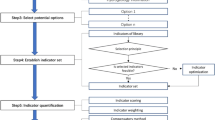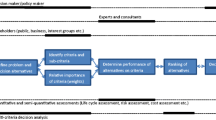Abstract
The relative risk analysis is a screening tool implemented to assess sites affected by actual or suspected contamination and suggest priorities for further actions (characterization, risk assessment, remediation, etc.). Its purpose is to provide technical assistance in the identification and prioritization of sites, which may represent a risk (high, medium, or low) according to their current or potential adverse impact on human health and/or the environment. This tool is relatively simple and applicable to all sites with a limited investigation, such as abandoned large areas (megasites) that are suspected to be contaminated. For these reasons, it can be a very useful tool in environmental policy supporting decision makers involved in the megasites revitalization in the sustainable local or even regional planning process. Megasites management is a very complex process for many features, such as a possible occurrence of multiple contamination sources, general lack of information, multiple site owners/stakeholders/end users, economic and planning implications at all relevant (regional and local) levels. At the same time, megasites may represent considerable environmental and health risks as well as an opportunity for sustainable local and regional development. This article presents a relative risk model as an innovative and simple approach that can be applied to potentially contaminated large areas for recognition and management of “critical” sub-areas, requiring characterization actions, and “not-critical” sub-areas, where redevelopment can start more easily and faster.


Similar content being viewed by others
Notes
In Italy, megasites often correspond to Sites of National Interest (S.I.N.), that are directly managed by the government, on the basis of possible risk to human health and environment. Indeed, these sites include mainly large areas (megasites) characterized, above all, by major industrial plants and harbours, but also by smaller areas, such as landfills where a potential high level of soil and groundwater contamination occurs. Remediation and environmental recovery actions of these areas are defined at the national level and realized through a proper public financing program. Law of 9 December 1998, n. 426, has identified the first list of remedial actions of national interest.
References
Agostini P, Carlon C, Critto A, Marcomini A (2007) A step toward contaminated megasites management: six European experiences at comparison. In: Velinni AA (ed) Landfill. Research trends. Nova Science Publishers Inc, New York, pp 47–75
Bardos RP, Bone BD, Boyle R, Evans F, Harries ND, Howard T, Smith JW (2016) The rationale for simple approaches for sustainability assessment and management in contaminated land practice. Sci Total Environ 563:755–768
Bartke S, Bittens M, Bleicher A, Finkel M, Groβ M, Rein A (2012) Introducing the FP7 project TIMBRE-tailored Improvement of Brownfield Regeneration in Europe. In: Conference short paper at NORDROCS 2012 4th joint Nordic meeting on remediation of contaminated sites, Oslo, Norway, 18–21 Sept 2012. https://www.timbreproject.eu/tl_files/timbre/Intern/4%20Work%20Packages/WP7/Events%202012/Nordrocs2012%20CABERNET2012/20120919_Nordrocs_Session-IV-onsdag-2-Bartke-Short-paper.pdf
Carlon C, Critto A, Marcomini A, Bazzanella I, Silvoni S, Samiolo M, Nadal N, Foramiti S, Manante M, Mannino I, Soriani S, Zanetto G, Giove S, Ramieri E, Dentone L, Petruzzelli GA, Facchinetti G, Mastroleo G (2003) DESYRE: sistema di supporto alle decisioni su base GIS per la bonifica dei siti contaminati. Siti contaminati 3:84–94
Carlon C, Pizzol L, Critto A, Marcomini A (2008) A spatial risk assessment methodology to support the remediation of contaminated land. Environ Int 34(3):397–411
CL:AIRE: Leading Sustainable Land Reuse (2010) A framework for assessing the sustainability of soil and groundwater remediation, SuRFUK report. https://www.claire.co.uk/surfuk
European Commission (2016) Future brief. No net land take by 2050? http://ec.europa.eu/environment/integration/research/newsalert/pdf/no_net_land_take_by_2050_FB14_en.pdf
EEA: European Environment Agency (2004) Towards an EEA Europe-wide assessment of area under risk for soil contamination, vol. II. Review and analysis of existing methodologies for preliminary risk assessment. http://www.eionet.europa.eu/software/prams/release1/PRAMS2_ReviewMethodologies.pdf
EEA: European Environment Agency (2005) Towards an EEA Europe-wide assessment of area under risk for soil contamination, vol I. Background and outcomes of the project. https://www.eionet.europa.eu/software/prams/release1/PRAMS1_Background.pdf
Frongia F, Melis G, Muntoni A (2016) Nuovi spunti per le procedure di regionalizzazione nei piani di caratterizzazione. ASITA. http://atti.asita.it/ASITA2016/Pdf/141.pdf
Good IJ (1991) Weight of evidence and the Bayesian likelihood ratio. In: Aitken CGG, Stoney D (eds) The use of statistics in forensics science. CRC Press, Boca Raton, pp 85–106
Groβmann J, Sievers J, Ritter A, Keil M (2005) IMS—a risk based management approach for megasites, example Bitterfeld megasite, Germany. In: Thomson NR (ed) Bringing ground-water quality. Research to the watershed scale. International Association of Hydrological Sciences. IAHS Publication 297, Wallingford, pp 256-261
Holland KS, Lewis RE, Tipton K, Karnis S, Dona C, Petrovskis E et al (2011) Framework for integrating sustainability into remediation projects. Remediation 21(3):7–38
ITRC: Interstate Technology and & Regulatory Council (2011) Green and sustainable remediation. A practical frame work. ITRC report GSR-2. ITRC, Washington, DC. http://www.itrcweb.org/Documents/GSR-2.pdf
Landis WG (2005) Regional scale ecological risk assessment. In: Landis WG (ed) Using the relative risk model. CRC Press, Washington, D.C
Linkov I, Loney D, Cormier S, Satterstrom FK, Bridges T (2009) Weight of evidence evaluation in environmental assessment: review of qualitative and quantitative approaches. Sci Total Environ 407:5199–5205
Locantore NW, Tran LT, O’Neil RV, McKinnis PW, Smith ER, O’Connell M (2004) An overview of data integration methods for regional assessment. Environ Monit Assess 94:249–261
Muhlbauer WK (2004) Pipeline risk management, manual ideas, techniques, and resources, 3rd edn. Gulf Professional Publishing, Burlington
NICOLE: Network for Industrially Contaminated Land in Europe (2010) Road map for sustainable remediation. http://www.nicole.org/uploadedfiles/2010-wg-sustainable-remediation-roadmap.pdf
Regione Campania (2005) Piano Regionale di Bonifica dei siti inquinati della Regione Campania (Remediation Plan of contaminated areas of Campania Region). http://www.sito.regione.campania.it/burc/pdf05/burcsp09_09_05/pianoregionale_bonifica.pdf
Rein A, Popp S, Zacharias S, Leven C, Bittens M, Dietrich P (2011) Comparison of approaches for the characterization of contamination at rural megasites. Environ Earth Sci 63:1239–1249
Serapiglia F, Sievers J, Finkel M (2005) Risk-based design of cost-efficient remediation strategies at megasites. In: Thomson NR (ed) Bringing ground-water quality. Research to the watershed scale. International Association of hydrological sciences, IAHS Publication 297, Wallingford, pp 249–255
Shädler S, Morio M, Bartke S, Finkel M (2012) Integrated planning and spatial evaluation of megasite remediation and reuse options. J Contam Hydrol 127(1–4):88–100
Sitarz D (1994) Agenda 21: the earth summit strategy to save our planet. EarthPress, Boulder
Smith JW, Kerrison G (2013) Benchmarking of decision-support tools used for tiered sustainable remediation appraisal. Water Air Soil Pollut 224(12):1706
TIMBRE Consortium (2014) The megasite management guideline. EC project. http://www.ufz.de/mmt-guideline-en/epaper/epaper.pdf
W.e.l.co.me.: Water, Ecology, Landscape at contaminated Megasites (2004). http://publicwiki.deltares.nl/display/imsw/The+Welcome+Project
Acknowledgements
I thank Dr. Francesca Quercia (ISPRA) for his critical reading that greatly improved the manuscript. I also thank Dr. Patrizia Chessa, Dr. Paolo Littarru, Dr. Nicoletta Sannio (Department of Environmental Protection of the Sardinian Regional Government) for their valuable comments and for providing useful information about updates of this project.
Author information
Authors and Affiliations
Corresponding author
Additional information
Publisher's Note
Springer Nature remains neutral with regard to jurisdictional claims in published maps and institutional affiliations.
Rights and permissions
About this article
Cite this article
Andrisani, M.G. Relative risk assessment in support of the management of potentially contaminated megasites. Rend. Fis. Acc. Lincei 30, 389–398 (2019). https://doi.org/10.1007/s12210-019-00802-y
Received:
Accepted:
Published:
Issue Date:
DOI: https://doi.org/10.1007/s12210-019-00802-y




